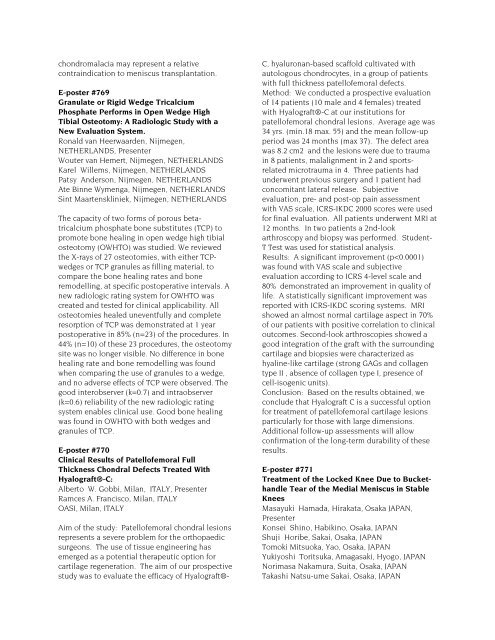POSTER ABSTRACTS - ISAKOS
POSTER ABSTRACTS - ISAKOS
POSTER ABSTRACTS - ISAKOS
Create successful ePaper yourself
Turn your PDF publications into a flip-book with our unique Google optimized e-Paper software.
chondromalacia may represent a relative<br />
contraindication to meniscus transplantation.<br />
E-poster #769<br />
Granulate or Rigid Wedge Tricalcium<br />
Phosphate Performs in Open Wedge High<br />
Tibial Osteotomy: A Radiologic Study with a<br />
New Evaluation System.<br />
Ronald van Heerwaarden, Nijmegen,<br />
NETHERLANDS, Presenter<br />
Wouter van Hemert, Nijmegen, NETHERLANDS<br />
Karel Willems, Nijmegen, NETHERLANDS<br />
Patsy Anderson, Nijmegen, NETHERLANDS<br />
Ate Binne Wymenga, Nijmegen, NETHERLANDS<br />
Sint Maartenskliniek, Nijmegen, NETHERLANDS<br />
The capacity of two forms of porous betatricalcium<br />
phosphate bone substitutes (TCP) to<br />
promote bone healing in open wedge high tibial<br />
osteotomy (OWHTO) was studied. We reviewed<br />
the X-rays of 27 osteotomies, with either TCPwedges<br />
or TCP granules as filling material, to<br />
compare the bone healing rates and bone<br />
remodelling, at specific postoperative intervals. A<br />
new radiologic rating system for OWHTO was<br />
created and tested for clinical applicability. All<br />
osteotomies healed uneventfully and complete<br />
resorption of TCP was demonstrated at 1 year<br />
postoperative in 85% (n=23) of the procedures. In<br />
44% (n=10) of these 23 procedures, the osteotomy<br />
site was no longer visible. No difference in bone<br />
healing rate and bone remodelling was found<br />
when comparing the use of granules to a wedge,<br />
and no adverse effects of TCP were observed. The<br />
good interobserver (k=0.7) and intraobserver<br />
(k=0.6) reliability of the new radiologic rating<br />
system enables clinical use. Good bone healing<br />
was found in OWHTO with both wedges and<br />
granules of TCP.<br />
E-poster #770<br />
Clinical Results of Patellofemoral Full<br />
Thickness Chondral Defects Treated With<br />
Hyalograft®-C:<br />
Alberto W. Gobbi, Milan, ITALY, Presenter<br />
Ramces A. Francisco, Milan, ITALY<br />
OASI, Milan, ITALY<br />
Aim of the study: Patellofemoral chondral lesions<br />
represents a severe problem for the orthopaedic<br />
surgeons. The use of tissue engineering has<br />
emerged as a potential therapeutic option for<br />
cartilage regeneration. The aim of our prospective<br />
study was to evaluate the efficacy of Hyalograft®-<br />
C, hyaluronan-based scaffold cultivated with<br />
autologous chondrocytes, in a group of patients<br />
with full thickness patellofemoral defects.<br />
Method: We conducted a prospective evaluation<br />
of 14 patients (10 male and 4 females) treated<br />
with Hyalograft®-C at our institutions for<br />
patellofemoral chondral lesions. Average age was<br />
34 yrs. (min.18 max. 55) and the mean follow-up<br />
period was 24 months (max 37). The defect area<br />
was 8.2 cm2 and the lesions were due to trauma<br />
in 8 patients, malalignment in 2 and sportsrelated<br />
microtrauma in 4. Three patients had<br />
underwent previous surgery and 1 patient had<br />
concomitant lateral release. Subjective<br />
evaluation, pre- and post-op pain assessment<br />
with VAS scale, ICRS-IKDC 2000 scores were used<br />
for final evaluation. All patients underwent MRI at<br />
12 months. In two patients a 2nd-look<br />
arthroscopy and biopsy was performed. Student-<br />
T Test was used for statistical analysis.<br />
Results: A significant improvement (p
















